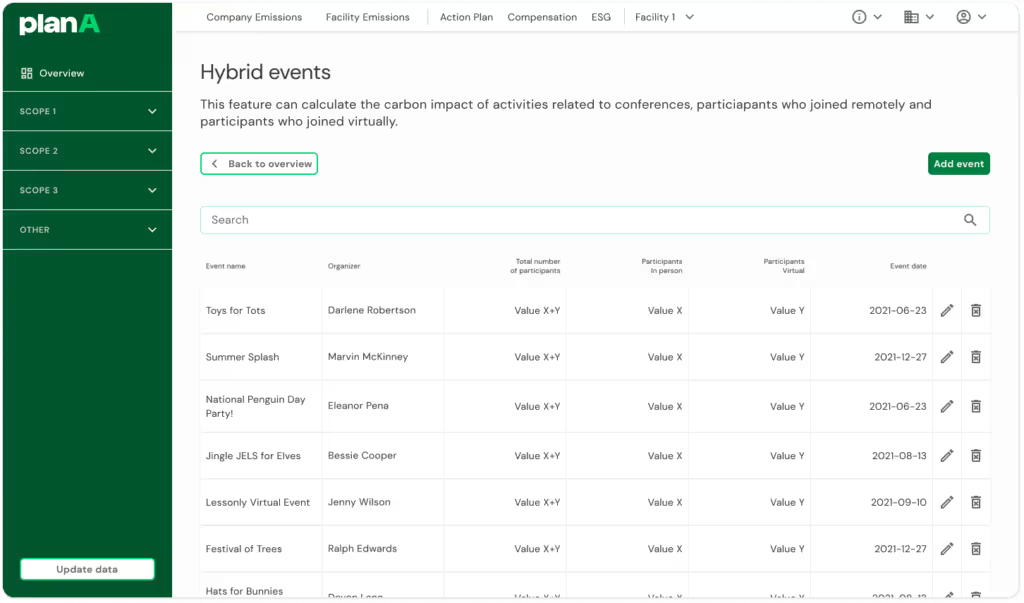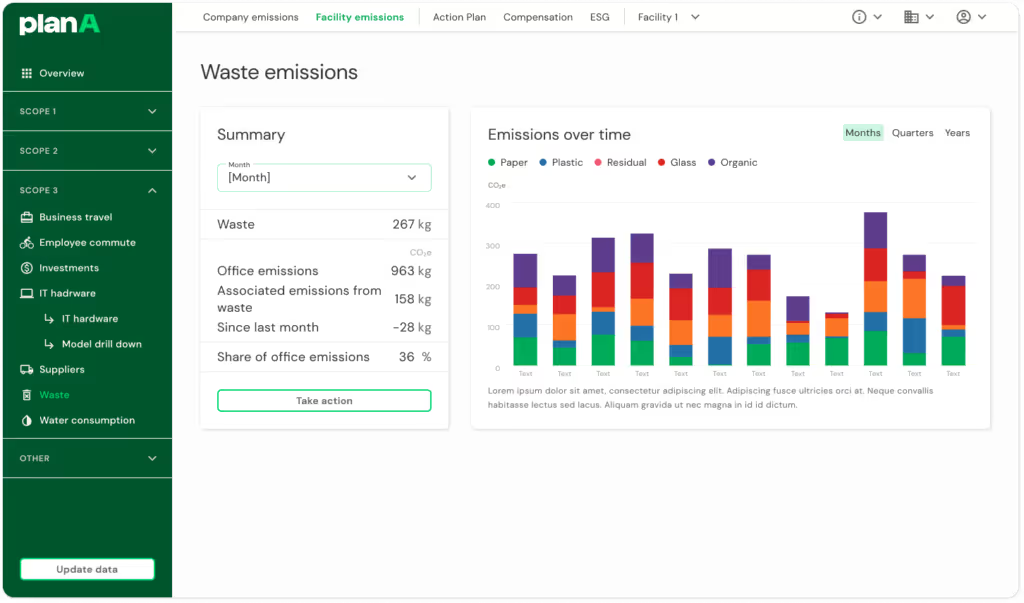All emission scopes must be monitored to disclose a company's entire carbon footprint. Due to the technical tracking challenge, companies tend to focus on scopes 1 & 2 of emissions - relating to fuel and electricity. Nonetheless, the third scope of emission - indirect emissions - represents between 60 and 90% of a company's emissions. This is where companies' decarbonisation efforts should be concentrated. Plan A is proud to introduce three new modules: events management, waste, and business travel, to support companies in analysing and reducing their carbon emissions drastically.
We'll look back at our recent feature releases at the end of each quarter and share some insights. Without further ado, here are some of the best features on the Plan A platform in the first quarter of 2022.
🎟 Hybrid event calculator
With the easing of Corona measures, hybrid and physical events are back - with corona born virtuals, ones are here to stay. According to the University of Freiburg, each visitor causes an average of 0.5 to 1.5 tonnes of CO2 equivalents in a three-day conference. To achieve the Paris 1.5-degree target, each person worldwide would have to emit 2.5 tonnes of CO2 equivalents annually by 2030. This example shows how essential event emissions are measured and how significant it is to reduce them.
Learn more about virtual events: Calculate the environmental impact of virtual events
What does it do? The Hybrid Event calculator allows you to measure your hybrid events' emissions, including in-person and remote sessions. The automated calculation lets you fill in your details into the predefined fields - easing the pain associated with data collection and covering all aspects from events management to carbon accounting.

Credit: Plan A
Why is it useful? This calculator is the latest addition to our events calculator family, including the fully remote and physical events modules. The hybrid event module mixes both formats, as this event is becoming more common. Now you'll easily be able to track emissions for all event formats that your company is hosting.
How does it work? The data collection phase is split into simple steps, covering basic event information, energy usage, and travel modes. Our platform will guide you through the tool. Once the data collection is complete, you will be able to see that data in your 'Event emissions' dashboard.
♻️ Waste management
Why does it matter? According to Eurostat, waste is the fourth most significant source of emissions in the EU. Respectively, in 2050, the world will generate 3.4 billion tonnes of waste per year. Therefore, companies must disclose this primary source of emissions to accurately cover all of their emissions.
What does it do? The waste emissions module allows you to add and oversee operational waste data for different waste categories, giving you insight into your Scope 3 Category 5 emissions.

Why is it useful? It will allow you to see what type of waste has the highest emissions, enabling you to make more informed decisions for reduction. You can also track your waste emissions over time, as a whole and per category, to see the results of your reduction actions.
How does it work? As the user, simply input the amount of waste in kilograms. Plan A now makes it possible to include collecting data from various waste categories – including five types of waste: plastic, paper, glass, organic, and residual waste – in the platform, thus creating visibility for the emissions in this sector and initiating targeted measures to reduce waste.
🚆 Business travel
Why does it matter? Business travel is increasing as the world transitions out of a global pandemic. Plan A's upgraded business travel module lets data be uploaded to the platform either following our data collection wizard or bulk upload. Distance-based emissions calculation methods are also supported to ensure the high accuracy of emissions calculations. By flexibly adding departure and arrival locations for a business trip, the Business Travel module automatically calculates the distance travelled and the resulting carbon emissions based on the transport type. The dashboard then provides an overview of all business trips and their respective emissions.
What does it do? The Business Travel module covers Scope 3 Category 6 emissions, allowing users to gather data for all business trips taken for the company. Once uploaded, you'll be able to see all trips organised in a table format, with high-level data visualised in graphs on your business travel emissions dashboard.

Credit: Plan A
Why is it useful? As a user, you will get a clear picture of emissions per type of transport (flights, road, rail, ship) over time and the distance travelled for these journeys. Businesses can implement company-wide actions to reduce emissions across categories with this information. For example, this could be a policy to encourage train travel for trips under 500km.
How does it work?
- Each trip's data is fed into the platform with our downloadable template using the manual input or CSV upload. Data collection covers several areas, such as date, type of transport, arrival/departure dates and the number of employees travelling.
- Our platform automatically calculates the distance travelled and the resulting carbon emissions using distance-based emissions calculations based on the transport type. Additionally, these emissions will correspond to a specific month, quarter or year in your emissions dashboard.






